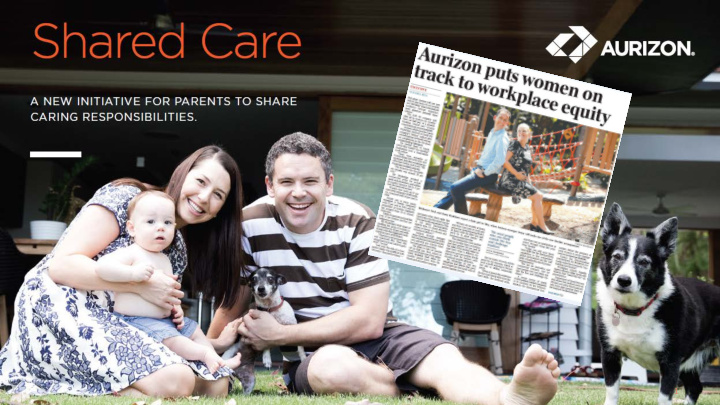



1
Why tackle equalisation of caring? Liz Broderick (former sex discrimination commissioner): “If I had to choose one thing to change, it would be for caring responsibilities to be shared equally between men and women.”
How does shared care work? • For Aurizon ‘mums’ • For Aurizon ‘dads’
Key equity considerations • Applies to same sex couples and adoptive parents • Requires leave from a full-time role for ‘dad’ • Requires return to a full-time position for ‘mum’ • Based around 50% pay for ‘dad’ • Must be taken within the first year
Costings Last financial year 4.8% of Aurizon’s workforce took some form of paid parental leave. This includes mothers and fathers. With ABS data indicating around 2% of working women having a child every year, the Aurizon experience is likely to be typical of most employers. Based on the projections below and Aurizon’s FY15 labour costs – we believe that Shared Care will have a wages impact of just over 0.1% after 3 years. The steps and the table below (and on the following slide) outline how Aurizon estimated the costs of the ‘Shared Care’ initiative. Eligibility for ‘Shared Care’ is for families in which both partners work full-time and both partners can access a period of unpaid leave. It is also available to single parents who work full-time. Eligibility Determine how many men and women took parental leave in the past 12 months – if everything else is equal this provides you with a rough guide as to how many employees may be eligible each year. Based on what we know from internal data and the ABS we determined the likely eligibility rate for Shared Care was 60% of parental leave instances. This is based on the percentage of men whose partners are employed and the percentage of women whose partners are likely to have access to extended unpaid leave from their employer. Participation Given the lack of equivalent programs, the estimation of participation rates was more difficult to ascertain. Given however the program is implemented in response to prevailing financial and cultural norms, Aurizon has projected participation rates potentially beginning at 10% of eligible parental leave instances and growing to 30% by year 3. Calculation Identify average salary of the women who took parental leave and identify average male salary. Use these as the average weekly cost for women and men respectively. Duration For each of the men and women - multiply the number of people you have estimated will take this up (C and G respectively) by 26 (the maximum number of weeks) by 50% of average weekly wages to obtain your estimated total cost for men (D) and women (H) and then add these together to obtain total estimated cost.
Costings (CONT’D) Ke Key A Represents the number of men in your organisation who took parental leave in FY15 B Sum of A multiplied by projection of 60% eligibility C Sum of B multiplied by projected participation rates D Sum of C x 26 weeks x 50% of avg. weekly wages E Represents the number of women at your company who went on maternity leave in FY15 F Sum of E multiplied by projection of 60% eligibility G Sum of F multiplied by projected participation rates H Sum of G x 26 weeks x 50% of avg. weekly wages Projected Projected Calculation (Men) Projected Projected Calculation (Women) Total est. eligible men participating Men eligible women participating costs women 60% x A = B B x 10% = C C x 26 x 50% avg. weekly 60% x E = F F x 10% = G G x 26 x 50% avg. weekly D + H Year 1 wages = D wages = H 60% x A = B B x 20% = C C x 26 x 50% avg. weekly 60% x E = F F x 20% = G G x 26 x 50% avg. weekly D + H Year 2 wages = D wages = H 60% x A = B B x 30% = C C x 26 x 50% avg. weekly 60% x E = F F x 30% = G G x 26 x 50% avg. weekly D + H Year 3 wages = D wages = H
Benefits of Shared Care For Aurizon families • More satisfaction for men. • Happier and healthier children who do better at school. For Aurizon • Attraction and retention and utilisation of talent • Childcare and flexibility no longer a ‘women’s issue
Impacts so far Take up - Seven men and four women (in six months). Feedback - Positive employee feedback at launch. - Positive feedback from participants. Research - long range study on the impact of shared care to be undertaken.
Recommend
More recommend